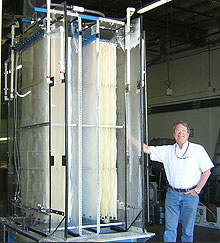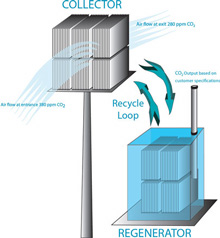Researchers have invented a phone-booth-size device that can take back emissions that have already built up in the atmosphere.
The Atmospheric Carbon CapturE SystemS (ACCESS) Air-Capture System, developed by Global Research Technologies in Tucson, Ariz., holds sheets of material capable of capturing CO2 molecules directly from open air. While that may sound tricky enough, "the hard part," says Klaus Lackner, a geophysicist at Columbia University, "is prying the carbon dioxide loose once you absorb it." Lackner worked with Global Research to create the technology.
To remove the molecules, the sheets are sprayed with a chemical solution that bonds to the carbon dioxide. The solution is then drained off to a separation unit, where the CO2 is isolated as pure gas through electrodialysis. A design goal was to avoid using toxic or corrosive chemicals that would require special handling, so ordinary PVC pipe is used to transfer the solution back to a collection unit so that it can be recycled.
Ideally, the ACCESS machines would be placed in clusters, similar to windmill groupings, near facilities capable of storing the carbon permanently. Unlike turbines, however, these devices can be placed anywhere. Locating them in windy areas would increase their efficiency by moving air across the surfaces more quickly, but they are not dependent on a strong breeze. "A windmill is not producing energy when the wind isn’t blowing, but the carbon-capture device can capture carbon, no matter what," Lackner says.
The current prototype captures less than 100 kilograms of CO2 per day, but Lackner predicts future models will capture 1 ton per day—several hundred times the amount saved by an equal-size windmill. New versions of ACCESS could capture carbon at a rate of about 3 kg per second, the same amount an average tree absorbs in a year. Still, millions of these devices would be needed to significantly cut global emissions. The Department of Energy estimates that the United States alone released 7075.6 million tons of CO2 in 2006.
The next step in developing the carbon-hungry machine is to design a model that can be easily mass produced. The technology won’t be ready tomorrow, but it’s not far off. "If it’s five years," Lackner says, "we run an awfully slow outfit."

